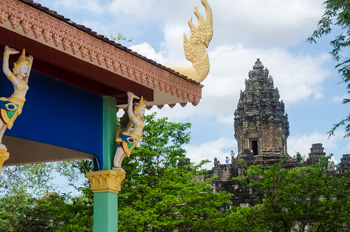
Tenaya
June
2014
Part One
Angkor Wat and more Cool Places
around Siem Reap, Cambodia
| |
| HOME |
| About Tenaya |
| About Us |
| Latest Update |
| Logs from Current Year |
| Logs from Previous Years |
| Katie's View |
| Route Map |
| Links |
| Contact Us |
![]()
May 28, 2014
"Two dollars for ten beautiful postcards," the girl interrupting our dinner says. We are sitting at an outside table for two in the fragrant, steamy, cramped Old Market.
"I don't send post cards," I say.
"Two dollars and keep ten beautiful cards for yourself."
"I'm going to take photos."
"Two dollars for ten beautiful postcards and peace and quiet."
Jim and I burst out laughing.
"Where are you from?"
"California."
"The capital of California is Sacramento."
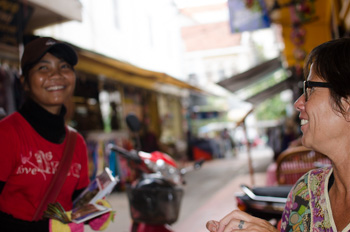
A girl selling rubbed drawings on rice paper outside Banteay Kdei says, "I don't want to tell you the price because then you will walk away like the Chinese."
"But how do I know if I want to buy one if I don't know the price?"
She thinks for a moment and then whispers the price into my ear. Secret bartering ensues.
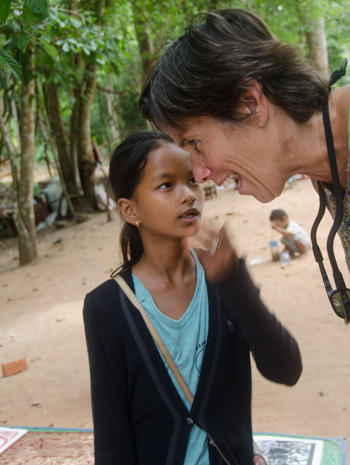
After I pay for a pair of pants and a shirt and wish her a good day, the woman outside Banteay Srei says, "In Cambodia we believe that if the first customer of the day is not stingy then we will have a good selling day. Thank you."
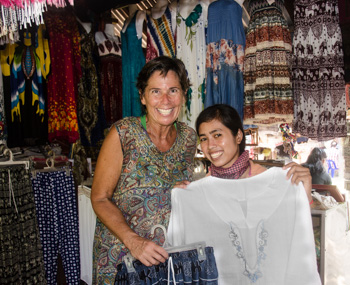
A girl named Nam sells woven pandanus leaf dragonflies outside of Banteay Samre. "Sorry they are not being nice and are bothering you," she says about the pushy girls. Jim buys three dragonflies from her.
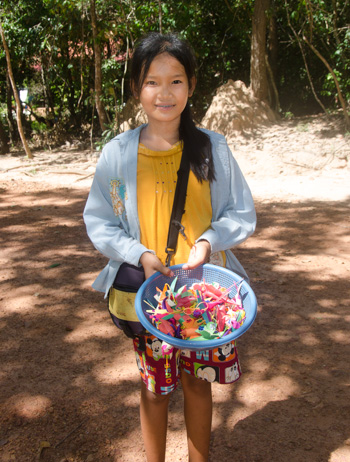
The people of Cambodia, the Khmer, are emerging after decades of oppression. The average income is less than US $1,000 per year. Many sell fish and produce. Some go to Thailand to earn money including women in the hospitality industry, a euphemism for the sex trade. Others peddle.
Micro finance has been hijacked here from the altruistic goals of Mohammad Yunus and groups like Kiva by unscrupulous people. Money is advanced for things like farm equipment and sewing machines and when the borrowers can't make the payments they are harassed and threatened. Kids are pulled out of school to work and help pay debts. Current day Khmers have no experience with capitalism. It's only been 35 years since the Khmer Rouge genocide ended and less time since the Vietnamese invasion.
The Khmer Empire, which lasted from the 9th-15 centuries, ruled much of South East Asia - from Myanmar to Vietnam. Kings built vast temples to honor and house Hindu gods, adorning the walls with carvings of the gods and of everyday life. Later Theravada Buddhism was introduced and the art of the Khmer temples became intertwined. The civilization thrived.
In 1992 Angkor was designated a UNESCO World Heritage Site. Restoration began and land mines were cleared so the rest of the world could enjoy these awesome archeological feats.
With these things in mind, we set off to see the famous Khmer sites.
Angkor Wat is the largest religious monument in the world and during its heyday had the highest population of any city in the world. It was constructed between 1100-1175 and represents the earthly and cosmic world. It was built to honor the Hindu god of Vishnu. It's also the main reason so many people visit Siem Reap, Cambodia each year. What better place to take a selfie at sunrise?
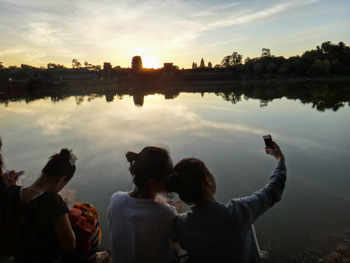
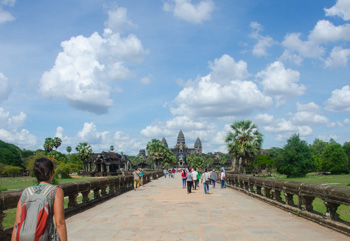
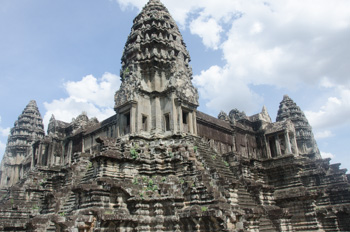
Above three photos - Angkor Wat
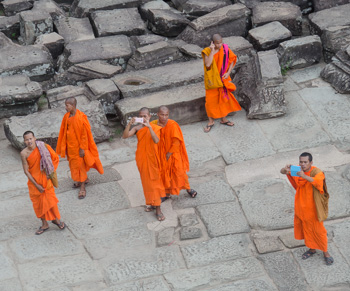
Monks at Angkor Wat
We spent four days travelling 300 kilometers by tuk tuk. Jeff, the owner of the lovely boutique Maison 557 hotel, arranged for Mr. Vuth to be our guide.
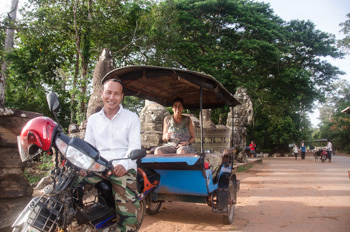
Mr. Vuth took us to all the 'must see' temples and later to some of his out-of-the-way favorites. The most popular were crowded, like Ta Prohm, subject of the iconic photo of the ficus roots overtaking the temple. Others were deserted. Timing is key if you want places to yourself. That and having a good guide.
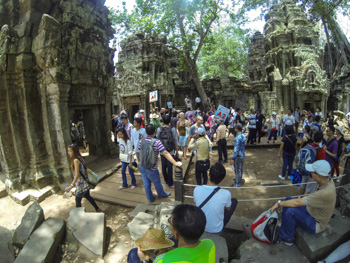
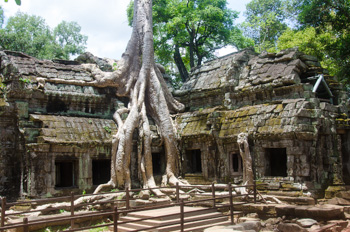
Above two photos - Ta Prohm
Central Angkor Thom is an ancient walled city dating from the 11th century. Bayon, Baphuon and the Terrace of Elephants are just a few of the sites here. South Gate and Victory Gate are two of the five entrances. Bridges span the gap that was once a moat. Each have a row of statues on either side. Those on the South Gate are still intact but the heads of those outside the Victory Gate were cut off during rougher times in the Khmer history.
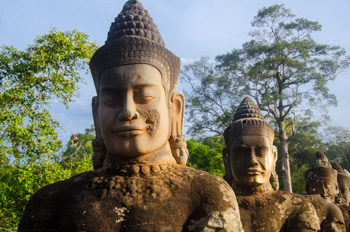
Gods depicted along the South Gate of Angkor Thom

Faces are carved in each of the four sides of all towers at Bayon
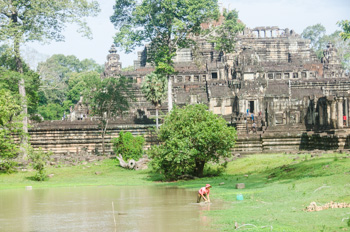
A woman fishes in front of Baphuon
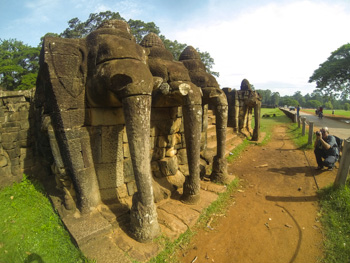
The Terrace of Elephants
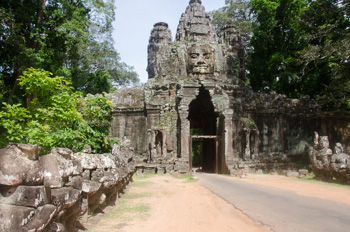
Statues were decapitated along the Victory Gate bridge
We reached Banteay Srei early and only a solo traveler and another couple were there. A policeman showed us many of the intricate carvings up close. It's amazing that something dating from the 10th century can be so well preserved. He sleeps in a hammock inside one of the towers to protect the temple at night and leaves at 8:00 AM when the park rangers arrive to deal with the tourists.
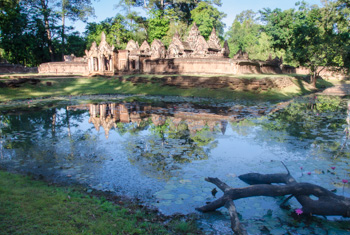
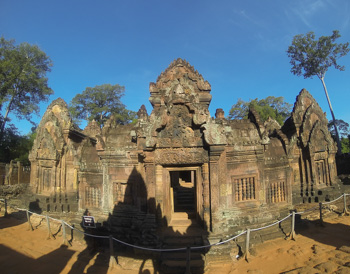
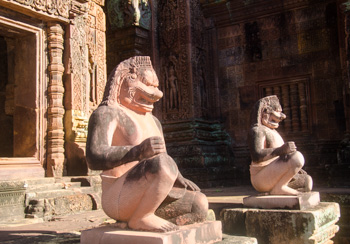
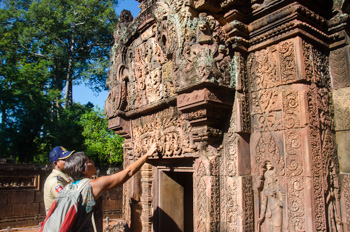
Above four photos - The intricately carved Banteay Srei Temple
There are two routes through the main group of Angkor temples, the Small and the Grand Tour Circuits. Ta Nei is between the two, just far enough out of the way that it is generally ignored. It's overgrown, unrestored, and shaded by the giant trees that have been slowly taking over. Only crickets broke the silence.
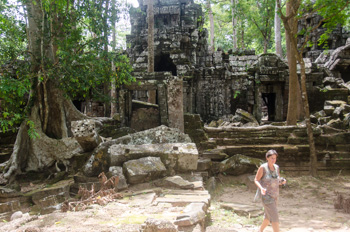
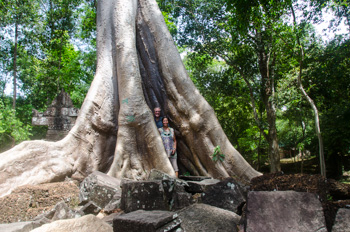
Giant ficus tree at Ta Nei
Banteay Samre was built in the 12th century. It is well-preserved and has undergone extensively restoration.
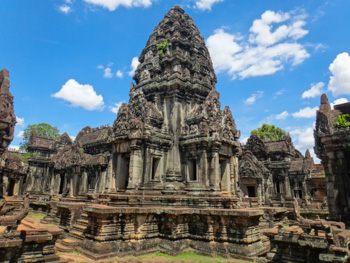
Banteay Samre
Construction on Ta Keo began in the 10th century but was never completed.
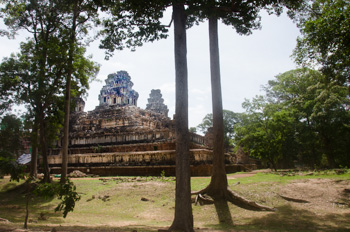
Ta Keo
Pre Rup means 'Turning the Body' and may indicate this temple was once used as a crematorium. It was a pretty place to watch the sunset.
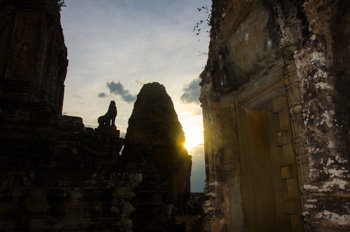
Sunset at Pre Rup
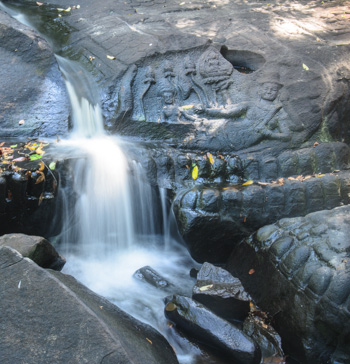
Carving in the Kbal Spean riverbed during the dry season
A shady 1.5 kilometer trail leads up through the woods to a carved riverbed called Kbal Spean. Better known as 'The River of a Thousand Lingas," carvings of gods are etched in the rocks. Lingas are a symbol of the Hindu god Shiva and Yoni are a symbol of the goddess Shakti. Together they represent the interconnectedness of male and female from which all life originates. During the dry season many of the carvings are exposed, but during the wet season they are submerged.
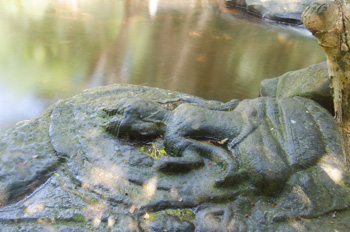
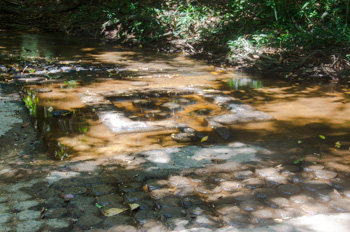
Carvings of a god and a linga and yoni at Kbal Spean
A few hundred meters further along, the river falls over a precipice and creates a wonderful spot to to relax and cool off. The Chinese men that came while I was standing under the falls did not expect me to intentionally slide down the mossy rocks. One jumped out to stop me as I landed in the pool and fell on top of me. Soon they were all sliding into the pool too.
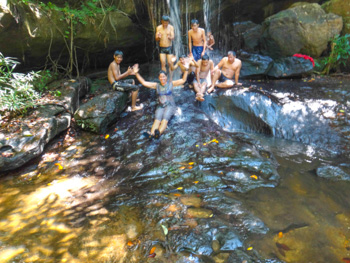
Katie demonstrates sliding down mossy rocks
Most people go to Phnom Bakheng for the sunset but, call us contrarians, we went for the sunrise. It's a 20 minute hike uphill along a dirt road, but the rewards are few people and gorgeous scenery.
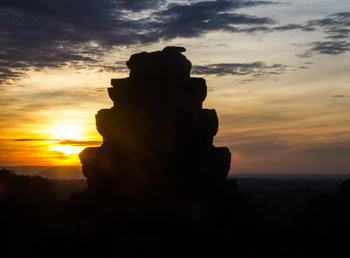
Phnom Bakheng at sunrise
Banteay Kdei was both a Hindu and Buddhist temple, depending on the time. Gods of both adorn the walls, carved in stone colored from white to grey to pink to orange. Hindu Buddhas hold their hands together at their chests with fingers pointed upward, Bhuddhist Buddhas hold their hands in their laps.
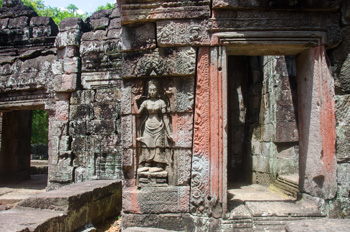
Banteay Kdei
It is a two hour ride to Beng Mealea, longer if you stop at Banteay Srei like we did. The long outer wall and jumble of blocks in the shadows of towering trees reveal something of what's beyond. Inside, a guide led us over fallen blocks, through narrow hallways, beneath crumbling doorways, around massive walls wrapped in enormous ficus roots and across the wide area that forms a moat in the wet season. Nothing has been restored. Here and there are wooden staircases built to help visitors negotiate the toughest spots.
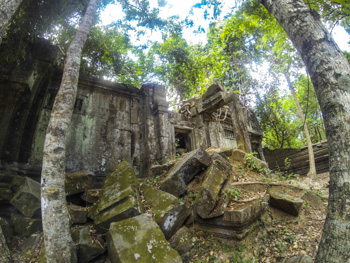
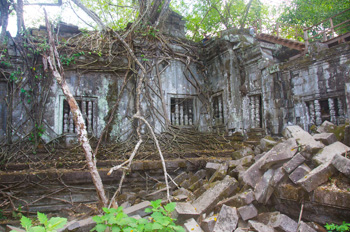
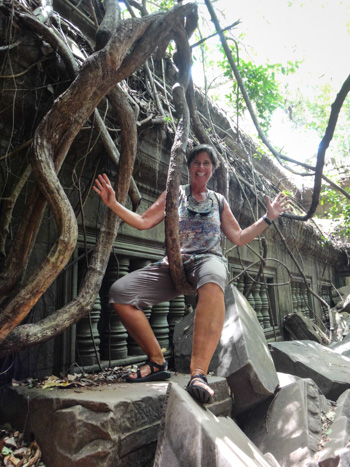
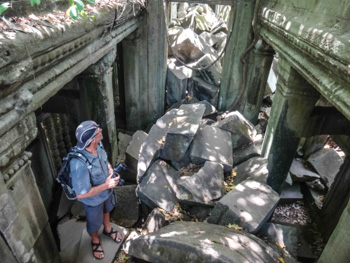
Above four photos from Beng Mealea
A sign outside the temple of Beng Mealea says 438 anti-personnel mines and 809 unexploded ordinance had been cleared from this site. Land mines are a big threat to life and limb in Cambodia. It is not recommended to venture away from roads anywhere in the country. We saw several men missing both arms.
Mr. Vuth cleared land mines for four years. His wage was $150 per month. It cost him $50 for food and $80 to get home. Not much went into his pocket for that dangerous job.
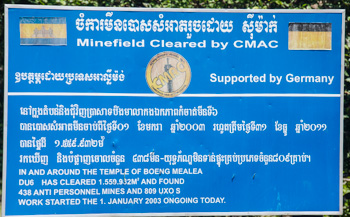
Results of minefield clearance at Beng Mealea
Chau Srei Vibol is one of Mr. Vuth's favorite temples. It's a fair distance from Siem Reap and involves many kilometers of dirt road. A new temple has been built on the hill alongside the old one. Mr. Vuth led us around and pointed out interesting carvings and explained the lingas. When we had finished, an old toothless woman living in a house nearby smiled and waved. She motioned putting food in her mouth so I gave her the bag containing two croissants and the remains of our baguette from breakfast, and some Khmer money.
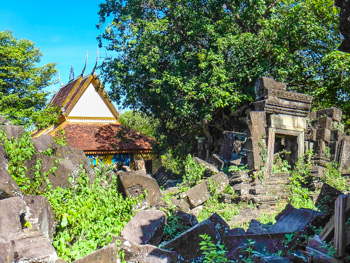
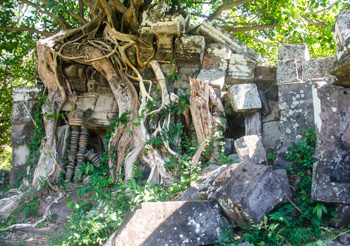
Giant roots overtake Chau Srei Vibol Temple
We trundled along miles of dirt roads, past small villages and vast rice fields to reach Trapeang Phong, Mr. Vuth's favorite temple of all. He led us across dried fields to a single tower rising out of the scrub. This area has more clay than stone so most of the tower is made of brick. We took his word that Angkor Wat could be seen from the top.
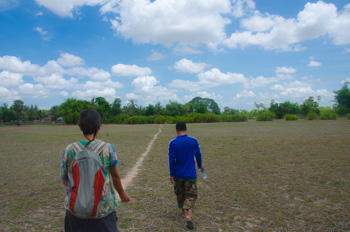
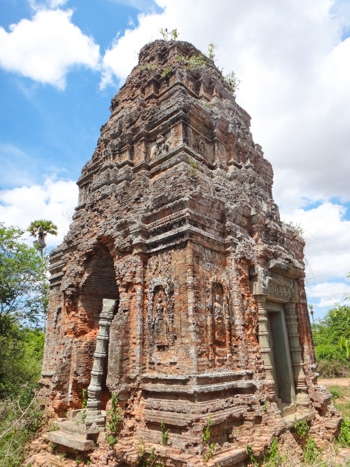
The approach and temple of Chau Srei Vibol
The Roluos Group are the oldest of the permanent Khmer temples and date to the 9th century. They include Bakong, Preah Ko and Lolei.
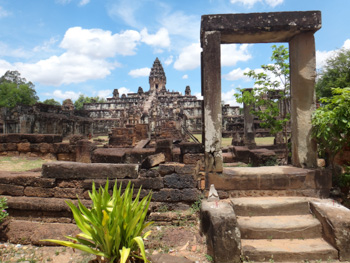
Bakong
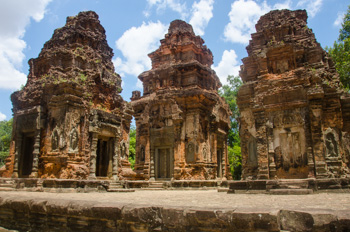
Preah Ko
Behind the ancient towers braced with wood and tufted with grass was a wooden building with orange robes draped over the railing. A monk saw us taking photos and came over. We talked. He is the head teacher at this school. He is 25 years old, had gone to university in Siem Reap, and speaks English, Chinese, Thai, Italian and Spanish.
It frustrates him that most children drop out of school to help their familiies make money. He understands the importance of education after Pol Pot and the Khmer Rouge killed all the educated people in his country.
The school receives donations of building materials, supplies and books. One shelf in the library holds several Acer computers that a company recently gave them.
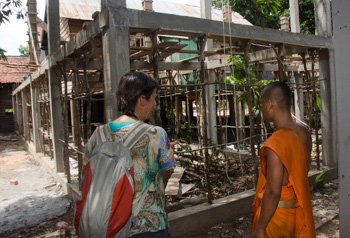
The head teacher at Lolei shows Katie the computer room under construction
Our guidebook made the stilt village of Kompong Phhluk sound interesting and a young Khmer woman we met while waiting for our flight out of Phuket suggested we visit, so we asked Mr. Vuth to take us there. It was the dry season and the milky brown river out to the lake was long and shallow. Houses on each side are built on stilts because the water rises that high during the wet season. We passed several people in boats. They were not friendly. If they looked at us at all, they glared. Not a single person smiled. It was so different from the pleasant encounters in other places. I was very uncomfortable.
But who can blame them? Boatloads of camera wielding voyeurists rumble through in unmuffled longtails looking into their houses and taking pictures of them just going about their daily routines. It really made us think about where we choose to visit, and why, and the impact we have on the people living there.
When we returned to Maison 557, Jeff said he does not recommend visiting this village for several reasons. A look at travel forums confirm that people have been taken out to the lake and shaken down for all the money they had before being allowed to return. Yikes, we're glad Mr. Vuth was with us to keep that from happening.
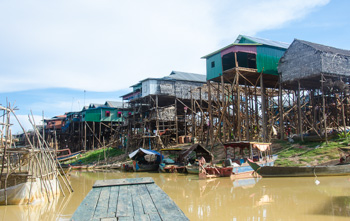
Four days was barely enough time to see all we wanted to see. It would have been nice to have spent a full day at the fabulous Angkor National Museum in Siem Reap half-way through our visit. Buying the three day pass, which is good for any three of seven consecutive days, is the way to go.
The day before yesterday Tenaya was loaded onto a cargo ship here in Phuket, Thailand bound for Istanbul. We'll meet her there in three weeks. In the meantime we'll do some land traveling in Laos and Vietnam, and visit Hong Kong. More about all these adventures in a few weeks.
Go to June 2014 Part Two - 300 Kilometers in a Tuk Tuk - Seim Reap, Cambodia
Go to Previous Page - More time in Thailand
